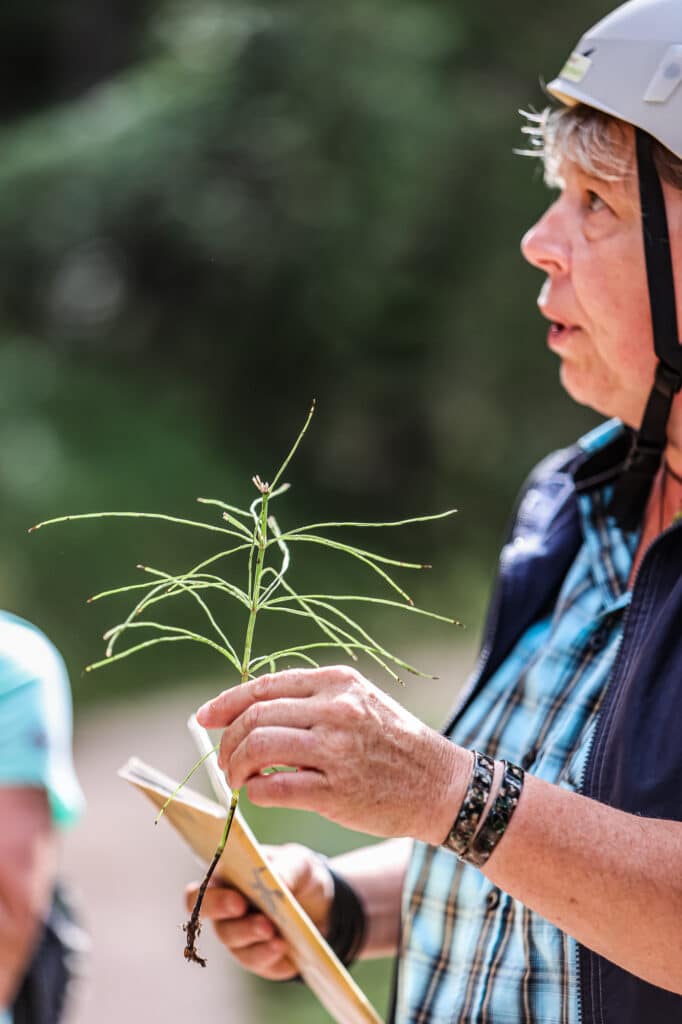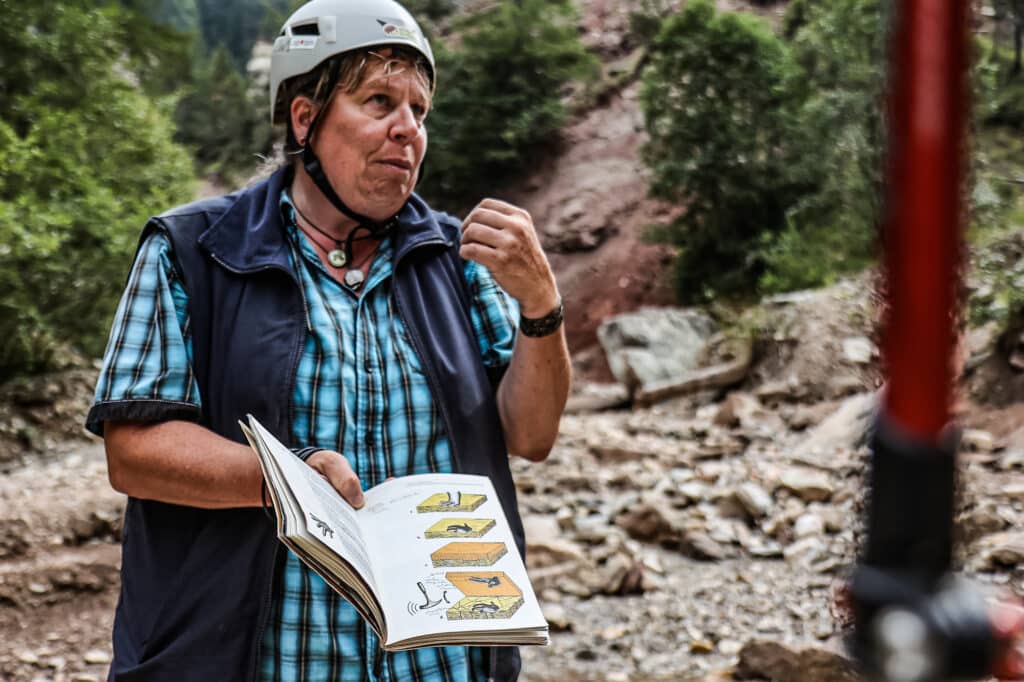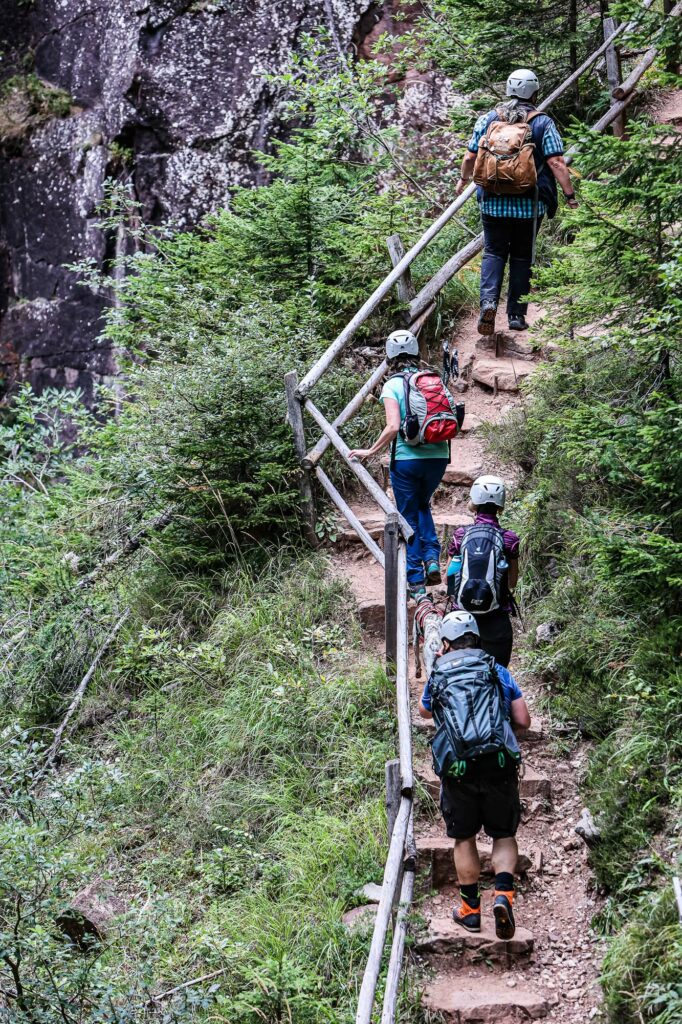An impressive experience: the hike through the Bletterbach gorge
Discover the origins of the Dolomites with geologist Irene! The unique beauty of the landscape attracts visitors to the Dolomites time and again. A hike through the Bletterbach gorge reveals the history of its origins. Once a week, the exploration of the “Grand Canyon of South Tyrol” is on the programme. A holiday experience of a special kind!
Certain messages are both unbelievable and shocking: “The Dolomites will no longer exist in the future,” says hiking guide and geologist Irene to her astonished audience, but immediately reassures them with her own humour: “But that will only happen in a million of years – so most of us probably won’t live to see it.” The incomparable beauty of the Dolomites, the mountains that Reinhold Messner considers as the most beautiful in the world, attracts countless guests to the Ganischgerhof in South Tyrol every year. Many enjoy the panorama every day while hiking, mountain biking or playing golf – however, a hike with Irene into the Bletterbach gorge, which is on the Ganis weekly programme every week, is something that nobody will forget.
Those who hop on the shuttle bus at Ganischgerhof in the morning probably have no idea what spectacle awaits them on the easy half-day hike through the “Grand Canyon of South Tyrol”. The tour starts after a 20-minute drive in Aldino at the visitor centre of the Geoparc Bletterbach. Irene hands out the obligatory safety helmets – even though the hike is not dangerous, safety is paramount in the huge gorge, which stretches over an altitude difference of 900 metres from the Weisshorn to its bottom.
Already on the descent down to the Bletterbach, Irene proves to be a walking encyclopaedia: ” Be careful not to confuse these plants,” she says regarding the plants that grow all over the meadow. “The flowers look like crocuses. And the leaves look like wild garlic – but it’s the autumn crocus, and it’s poisonous”. Fortunately, no one is hungry after the hearty breakfast at the Ganischgerhof, so this danger is averted. 😉
But nevertheless, after the short, steep path to the Bletterbach, everyone stands there with their mouths open in amazement. Below, a small rivulet splashes flanked by gigantic vertical rock faces to the left and right.
Irene explains in a captivating monologue how the spectacular gorge was formed here: the reddish Bolzano quartz porphyry forms the base of the gorge and was formed over 260 million years ago during volcanic eruptions. Above it, erosion and deposits under pressure created the Gardena sandstone. Later, when everything here was under water, the Bellerophon strata were formed from gypsum deposits, before the Werfen strata, rich in fossils and up to 400 metres high, settled on top. Finally, layer five is the Contrin formation, the rock of which the summit of the Weisshorn is composed.
On the hike through the Bletterbach gorge: the most beautiful pictures
Sounds complicated? Never fear, Irene is here. She knows all the answers on the roughly two-hour hike through the gorge, stopping again and again and explaining everything in easy-to-understand detail. “We are basically dealing with three events here,” says the hiking guide. “Event one is the rock formation of the five layers over 200 million years ago”, when – hardly imaginable – everything was still flat here. Event two, however, changed this fundamentally: “The Alps were then formed 100 million years ago”. The continental plates shifted, Africa pushed against Europe, which led to the folding of the Alps. Amazingly, even today, Irene explains, the Alps are still in the unfolding phase, growing by about one millimetre per year. However, erosion also leads to the removal of about one millimetre per year. Finally, the third event is comparatively juvenile and only 10,000 to 20,000 years old. When the glaciers thawed after the last ice age and as a result – as Irene says – “half the Weißhorn was eroded down”, the Bletterbach formed and dug further and further into the gorge.
When the weather is nice, it is now a small rivulet in the considerable dimensions of the gorge, where at the beginning the vertical rock walls bear witness to the formation of the Dolomites. Exploring the gorge is easy and enlightening, especially under expert guidance. Irene shows the imprints that dinosaurs and other creatures once left here, finds fossil plant remains and explains the fascinating nature on the hike until the head of the valley is reached at the Butterloch. Here, an impressive waterfall plunges over a 30-metre-high cliff into the depths.
But even on the way back it continues to be interesting: How did the Dolomites actually get their name? Why do Latemar and Marmolata belong to the Dolomites even though they are not dolomitic? And what tricks from the chemistry set can you actually use to precisely determine rock types on the way? Irene knows the answers. And even though she knows that the fate of the Dolomites will be sealed at some point, she says with a wink: “As long as we have the Alps, we want to enjoy them.”
Text and photos: Jens Vögele | 360°-Kommunikation
































